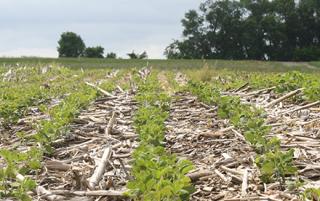On May 1, 2012, residents of Albany and Avon, Minnesota, were delayed from delivering May Day baskets when a sudden storm dropped buckets of rain on the towns. The May Day storm brought 2 to 3 inches of rain in one hour. It was a minor inconvenience for town folks but a major problem for farmers with flooded fields.

Unfortunately, this increased precipitation event is occurring more and more frequently in Stearns County of central Minnesota. From May 18 to 24 in 2013, the county received 4.17 inches of rain. On May 26, 2014, St. Martin received 5 inches in two hours. Five days later, Discovery Farm near Sauk Centre reported 7.15 inches of rain in one day.
If this wasn’t bad enough, the soggy springs have been followed by dry, windy summers. The result: increased erosion.
“We’re finding it difficult to keep up with erosion control in Stearns County due to the heavy rains,” says Brad Wenz with the Stearns County Soil and Water Conservation District. “We need to find ways to get more residue on the soil to take energy off the rain drop.”
Farmers eagerly looking for ways to hang onto their soil attended the recent “Managing Crop Residue to Stop Erosion, Cut Costs, and Sustain Yields” field day with stops throughout Stearns County. The four farms featured on the tour used conservation tillage methods, including strip-till and vertical tillage, as well as no-till. All four stated that erosion control was a major reason they moved from conventional tillage to their current system.
In addition to reducing erosion, Dan Ley has also enjoyed cutting back on fuel use for the eight years he has been no-tilling on his Richmond, Minnesota, farm. He estimates that he uses 1,000 fewer gallons of diesel fuel by cutting out tillage.
Joel Lauer from Fairhaven, Minnesota, has also found cost savings in switching from conventional tillage to strip-till. “The initial equipment investment, though large for a small operation, is not as bad as it seems when compared to the cost of conventional tillage equipment,” he says.
Strip-till came with a steep learning curve for Dustin Frieler, who farms near Greenwald, Minnesota. After seven years of experience, he has some simple advice. “The shape of the strip is very important, especially in fall strip-till,” he says. “The berm needs to be at least 3 inches high and hilled so there’s still a mound for the planter in the spring.” He recommends investing in good equipment, including hydraulic row cleaners for your planter.
Prepare to change your herbicide program when you implement a reduced tillage method. Ley saw fewer annual grasses and more perennial broad leaves, such as sow thistle and dandelions.
How do you get started? “First do your homework and read as much as you can about the different systems,” says John Christen, who has been no-tilling soybeans and strip-tilling corn for 27 years. “Talk to people who are doing what you want to do. You will make mistakes and may even have a few disasters. The important thing is that you learn from them.”





